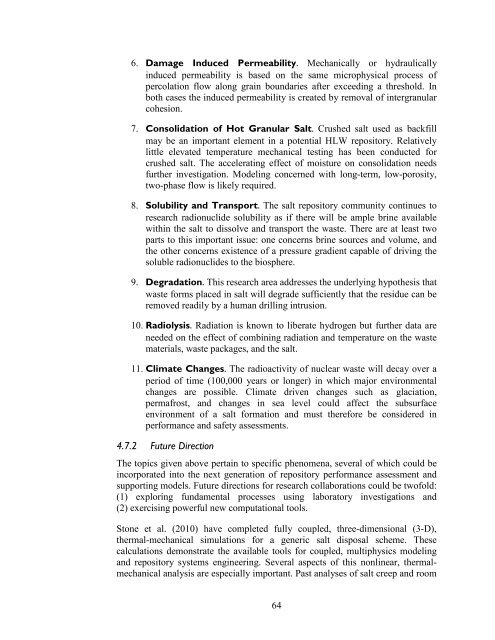Salt Disposal of Heat-Generating Nuclear Waste
Salt Disposal of Heat-Generating Nuclear Waste
Salt Disposal of Heat-Generating Nuclear Waste
You also want an ePaper? Increase the reach of your titles
YUMPU automatically turns print PDFs into web optimized ePapers that Google loves.
6. Damage Induced Permeability. Mechanically or hydraulically<br />
induced permeability is based on the same microphysical process <strong>of</strong><br />
percolation flow along grain boundaries after exceeding a threshold. In<br />
both cases the induced permeability is created by removal <strong>of</strong> intergranular<br />
cohesion.<br />
7. Consolidation <strong>of</strong> Hot Granular <strong>Salt</strong>. Crushed salt used as backfill<br />
may be an important element in a potential HLW repository. Relatively<br />
little elevated temperature mechanical testing has been conducted for<br />
crushed salt. The accelerating effect <strong>of</strong> moisture on consolidation needs<br />
further investigation. Modeling concerned with long-term, low-porosity,<br />
two-phase flow is likely required.<br />
8. Solubility and Transport. The salt repository community continues to<br />
research radionuclide solubility as if there will be ample brine available<br />
within the salt to dissolve and transport the waste. There are at least two<br />
parts to this important issue: one concerns brine sources and volume, and<br />
the other concerns existence <strong>of</strong> a pressure gradient capable <strong>of</strong> driving the<br />
soluble radionuclides to the biosphere.<br />
9. Degradation. This research area addresses the underlying hypothesis that<br />
waste forms placed in salt will degrade sufficiently that the residue can be<br />
removed readily by a human drilling intrusion.<br />
10. Radiolysis. Radiation is known to liberate hydrogen but further data are<br />
needed on the effect <strong>of</strong> combining radiation and temperature on the waste<br />
materials, waste packages, and the salt.<br />
11. Climate Changes. The radioactivity <strong>of</strong> nuclear waste will decay over a<br />
period <strong>of</strong> time (100,000 years or longer) in which major environmental<br />
changes are possible. Climate driven changes such as glaciation,<br />
permafrost, and changes in sea level could affect the subsurface<br />
environment <strong>of</strong> a salt formation and must therefore be considered in<br />
performance and safety assessments.<br />
4.7.2 Future Direction<br />
The topics given above pertain to specific phenomena, several <strong>of</strong> which could be<br />
incorporated into the next generation <strong>of</strong> repository performance assessment and<br />
supporting models. Future directions for research collaborations could be tw<strong>of</strong>old:<br />
(1) exploring fundamental processes using laboratory investigations and<br />
(2) exercising powerful new computational tools.<br />
Stone et al. (2010) have completed fully coupled, three-dimensional (3-D),<br />
thermal-mechanical simulations for a generic salt disposal scheme. These<br />
calculations demonstrate the available tools for coupled, multiphysics modeling<br />
and repository systems engineering. Several aspects <strong>of</strong> this nonlinear, thermalmechanical<br />
analysis are especially important. Past analyses <strong>of</strong> salt creep and room<br />
64
















